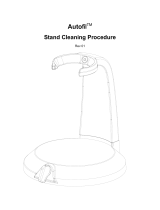
3
CONTENTS
Important Safety Information ................................................................................................. 5
I. Specications ...................................................................................................................... 7
A. Electrical and Refrigerant Data ..................................................................................... 7
1. F S ............................................................................................................................ 7
2. SRC ......................................................................................................................... 7
B. Dimensions/Connections .............................................................................................. 8
1. FS-1001MLJ-C ......................................................................................................... 8
2. FS-1022MLJ-C ........................................................................................................ 9
3. FS-1500MLJ-C ...................................................................................................... 10
4. SRC-10J .................................................................................................................11
5. SRC-14J ................................................................................................................ 12
II. Installation and Operating Instructions ............................................................................ 13
A. Location ...................................................................................................................... 13
1. Icemaker ................................................................................................................ 13
2. Remote Condensing Unit ....................................................................................... 14
B. Checks Before Installation ........................................................................................... 15
1. Icemaker ................................................................................................................ 15
2. Remote Condensing Unit ....................................................................................... 15
C. How to Remove Panels ............................................................................................... 16
1. Icemaker ................................................................................................................ 16
2. Remote Condensing Unit ....................................................................................... 16
D. Installation of the Icemaker ......................................................................................... 17
1. Dispenser Unit/Ice Storage Bin and Icemaker Setup ............................................. 17
2. Icemaker Electrical Connection ............................................................................. 18
3. Water Supply and Drain Connections .................................................................... 19
E. Installation of the Remote Condensing Unit ................................................................ 21
1. Remote Condensing Unit Setup ............................................................................. 21
2. Line Set Size and Refrigerant Charge ................................................................... 21
3. Line Set Installation ............................................................................................... 22
4. Remote Condensing Unit Electrical Connection .................................................... 24
F. Final Checklist .............................................................................................................. 25
G. Startup ........................................................................................................................ 26
H. Bin Control Check ....................................................................................................... 27
1. Infrared Sensor Check ........................................................................................... 27
2. Mechanical Backup Bin Control Check .................................................................. 29
3. Infrared Sensor Shutdown Delay ........................................................................... 30
a) Standard Ice Storage Bin ................................................................................... 30
b) Dispenser Unit .................................................................................................... 30
I. Operation Notes ........................................................................................................... 30
IMPORTANT
This manual should be read carefully before the appliance is installed and operated.
Read the warnings and guidelines contained in this manual carefully as they
provide essential information for the continued safe use and maintenance of the
appliance. Retain this manual for any further reference that may be necessary.

























